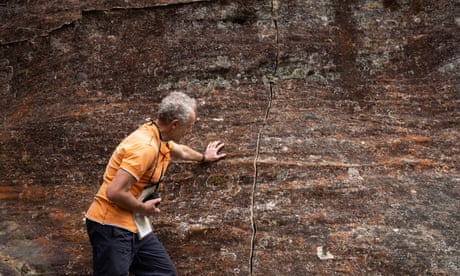- by foxnews
- 05 Mar 2025
‘It’s cracking’: fear rare rock formations at risk from NSW coalmine
‘It’s cracking’: fear rare rock formations at risk from NSW coalmine
- by theguardian
- 27 Jan 2022
- in news

Subsidence from an underground coalmine is leading to extensive surface cracking in a supposedly protected region of New South Wales, stoking locals' fears that rare rock formations could end up as rubble.
Centennial Coal officials are scheduled to meet government regulators on Thursday to discuss remediation for the extensive fracturing of stunning weathered sandstone shapes and cliffs within the 3,650 hectare Mugii Murum-Ban state conservation area, near Capertee, north-west of Sydney. The miner concedes the cracks exceed permitted levels.
Repairing the damage "is very hard", said Mary Thirlwall, a resident involved in landcare who has helped raise the alarm. "You can't jack up a mountain, you know, or fill in the cracks really that easily."
Whether Centennial receives any penalty for breaching the terms of its planning approval for the Mount Airly mine is being watched closely by conservation groups. Its many unusual rocks have been described as the "three hundred sisters", echoing the more famous "three sisters" at Katoomba in the Blue Mountains.
The nearby Gardens of Stone, a larger area of the remarkable, pagoda-like structures, was granted similar state conservation status last November. It too has had coalmining underneath and faces other development threats if tourism projects take off.
Centennial has been approved to mine in the Mount Airly region out to 2037. The next stage within the Mugii Murum-Ban area would be to extract coal under the adjacent Genowlan mesa, an even larger rocky landscape that could be more vulnerable to cliff collapses if there is similar fracturing as that at Mount Airly, according to Thirlwall.
"Airly and Genowlan are just iconic mesas," she said. "It's just a very special area."
A visit last weekend to explore for fractures found extensive fresh cracks, many of them marked out by equipment set up to monitor subsidence impacts after coal had been removed from seams about 300m below. Some of the fractures extended dozens if not 100m or more, splitting huge boulders and also more delicate rock features.
"It's scary how high we are above the mine, and it's still cracking," said Yuri Bolotin, a leading Blue Mountains and Wollemi conservationist and author of many guides, including a newly published one on Mugii Murum-Ban, A Bushwalking Paradise.
"This whole thing could come down, and become a pile of rubble," he said, standing in front of extensive cracks that had working their way up an entire cliff.
Bolotin had stumbled across some of the cracks in early January during a regular bushwalk with friends to take in the beautiful scenery. "Here's a crack that wasn't on my agenda," he said, finding a new one during last weekend's visit. "Imagine if we spent a whole day here."
Walking trails were signposted but there were no warning signs alerting walkers of the dangers of fractured rocks or the potential for more sinkholes forming.
Two areas off one fire track were fenced off with orange plastic mesh. These spots contained deep, long sinkholes, one of them apparently at least four metres deep.
A single paper sign, found on the ground near the main track, stated that the Airly Subsidence Monitoring Program was collecting "adequate pre-mining baseline data", as well as ongoing measuring of changes.
Centennial itself has not disputed the cracks were caused by its longwall mining to remove panels of coal in the 1.8m tonne a year operation.
It also accepts the fractures far exceed the consent condition that requires surface subsidence be limited to 125mm. Cracking damage associated with the above mine subsidence has been measured as up to 700mm wide and 3m deep, according to the Blue Mountains Conservation Society.
"Centennial became aware of an exceedance at its Airly mine in January 2020 and subsequently notified all stakeholders, including the New South Wales National Parks and Wildlife Service (NPWS) and the Department of Planning, Industry and Environment (DPIE)," a spokesperson for Centennial said.
"Centennial's Airly Community Consultative Committee (CCC) has been briefed on this issue and has been kept updated throughout." That committee, though, is not scheduled to meet until April, one member said.
"Centennial has undertaken a review of Airly's mine design and installed a 60-metre wide maingate pillar to prevent future subsidence incidents," the official said. "Moving forward, Airly mine designs will be based on assessments undertaken by SCT Operations, an independent specialist geotechnology consultancy."
A spokesperson for the parks service said the division would work with the NSW resources regulator and the company "with a view to ensuring all appropriate measures are taken to prevent and remediate damage in accordance with conditions of approval".
Guardian Australia approached the new environment minister, James Griffin, and the resource minister and deputy premier, Paul Toole, for comment.
In a letter to the government earlier this month, the Blue Mountains Conservation Society appealed for greater protection of an area that contains hundreds of pagoda rock formations and is home to rare and threatened species.
The Planning Assessment Committee (PAC) in its 2016 approval for Airly mine extension recognised the area as having "spectacular geodiversity with majestic cliffs and rock formations that are considered highly significant and delight the local community and visitors alike", the letter noted.
A repeat of the damage to Genowlan could be devastating for its pagoda-studded ridge lines and the fact it contains the only known population of the critically endangered Genowlan Point subspecies of Pultanaea, with just 15 known plants, it cited the committee as saying.
The NSW independent MP Justin Field said it was time to consider whether mining could coexist with state conservation areas.
"Time and again we see mining conditions are breached or are found to be inadequate after the damage is done to sensitive landscapes and waterways," Field said. "It raises serious questions about the ability of the planning system to identify and manage mining risks in state conservation areas."
- by foxnews
- descember 09, 2016
Popular travel destination breaks annual tourism record, sets new goal of 60M visitors
After breaking an annual tourism record in 2024, Japan looks to reach 60 million visitors by 2030. Officials tell Fox News Digital how Japan plans to attract visitors.
read more


